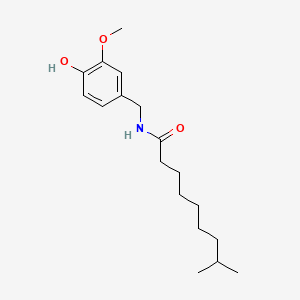| MeSH term | MeSH ID | Detail |
|---|---|---|
| Pain | D010146 | 64 associated lipids |
| Body Weight | D001835 | 333 associated lipids |
| Arthritis | D001168 | 41 associated lipids |
| Weight Gain | D015430 | 101 associated lipids |
| Tachycardia | D013610 | 7 associated lipids |
| Hypothermia | D007035 | 19 associated lipids |
| Out-of-Hospital Cardiac Arrest | D058687 | 1 associated lipids |
Capsaicin
Capsaicin is a lipid of Fatty Acyls (FA) class. Capsaicin is associated with abnormalities such as Morphologically altered structure. The involved functions are known as inhibitors, Regulation, metaplastic cell transformation, Biochemical Pathway and Uptake. Capsaicin often locates in Tissue fiber, Mucous Membrane, Nerve Endings, group Ia axon and Membrane. The associated genes with Capsaicin are TRPV1 gene, WT-1, MAP1LC3A gene, EIF2S3 gene and SLC33A1 gene. The related experimental models are Transgenic Model.
Cross Reference
Introduction
To understand associated biological information of Capsaicin, we collected biological information of abnormalities, associated pathways, cellular/molecular locations, biological functions, related genes/proteins, lipids and common seen animal/experimental models with organized paragraphs from literatures.
What diseases are associated with Capsaicin?
Capsaicin is suspected in Morphologically altered structure and other diseases in descending order of the highest number of associated sentences.
Related references are mostly published in these journals:
| Disease | Cross reference | Weighted score | Related literature |
|---|
Possible diseases from mapped MeSH terms on references
We collected disease MeSH terms mapped to the references associated with Capsaicin
PubChem Associated disorders and diseases
What pathways are associated with Capsaicin
Lipid pathways are not clear in current pathway databases. We organized associated pathways with Capsaicin through full-text articles, including metabolic pathways or pathways of biological mechanisms.
Related references are published most in these journals:
| Pathway name | Related literatures |
|---|
PubChem Biomolecular Interactions and Pathways
Link to PubChem Biomolecular Interactions and PathwaysWhat cellular locations are associated with Capsaicin?
Visualization in cellular structure
Associated locations are in red color. Not associated locations are in black.
Related references are published most in these journals:
- Am. J. Physiol. (1)
- Am. J. Physiol. Regul. Integr. Comp. Physiol. (1)
- Drug Metab. Dispos. (1)
- Others (1)
| Location | Cross reference | Weighted score | Related literatures |
|---|
What functions are associated with Capsaicin?
Related references are published most in these journals:
| Function | Cross reference | Weighted score | Related literatures |
|---|
What lipids are associated with Capsaicin?
There are no associated biomedical information in the current reference collection.
What genes are associated with Capsaicin?
Related references are published most in these journals:
- Am. J. Physiol. Regul. Integr. Comp. Physiol. (2)
- Am. J. Physiol. (1)
- Drug Metab. Dispos. (1)
- Others (1)
| Gene | Cross reference | Weighted score | Related literatures |
|---|
What common seen animal models are associated with Capsaicin?
Transgenic Model
Transgenic Model are used in the study 'In vitro hepatic and skin metabolism of capsaicin.' (Chanda S et al., 2008).
Related references are published most in these journals:
| Model | Cross reference | Weighted score | Related literatures |
|---|
NCBI Entrez Crosslinks
All references with Capsaicin
Download all related citations| Authors | Title | Published | Journal | PubMed Link |
|---|---|---|---|---|
| Wang XR et al. | Capsaicin-loaded nanolipoidal carriers for topical application: design, characterization, and in vitro/in vivo evaluation. | 2017 | Int J Nanomedicine | pmid:28579775 |
| Elwood RW et al. | Aversive responses by shore crabs to acetic acid but not to capsaicin. | 2017 | Behav. Processes | pmid:28365460 |
| Pitcher MH et al. | Mild Social Stress in Mice Produces Opioid-Mediated Analgesia in Visceral but Not Somatic Pain States. | 2017 | J Pain | pmid:28219667 |
| Dahan S et al. | Dietary factors in rheumatic autoimmune diseases: a recipe for therapy? | 2017 | Nat Rev Rheumatol | pmid:28405001 |
| de Lacerda Neto LJ et al. | Gastroprotective and ulcer healing effects of hydroethanolic extract of leaves of Caryocar coriaceum: Mechanisms involved in the gastroprotective activity. | 2017 | Chem. Biol. Interact. | pmid:27871896 |
| Vendrely V et al. | Resveratrol and capsaicin used together as food complements reduce tumor growth and rescue full efficiency of low dose gemcitabine in a pancreatic cancer model. | 2017 | Cancer Lett. | pmid:28089829 |
| Urbina SL et al. | Effects of twelve weeks of capsaicinoid supplementation on body composition, appetite and self-reported caloric intake in overweight individuals. | 2017 | Appetite | pmid:28235621 |
| Hochkogler CM et al. | A 12-week intervention with nonivamide, a TRPV1 agonist, prevents a dietary-induced body fat gain and increases peripheral serotonin in moderately overweight subjects. | 2017 | Mol Nutr Food Res | pmid:28012242 |
| Kurosawa W et al. | Practical large-scale production of dihydrocapsiate, a nonpungent capsaicinoid-like substance. | 2017 | Biosci. Biotechnol. Biochem. | pmid:27838955 |
| Hurley JD et al. | Non-pungent long chain capsaicin-analogs arvanil and olvanil display better anti-invasive activity than capsaicin in human small cell lung cancers. | 2017 | Cell Adh Migr | pmid:27196129 |
